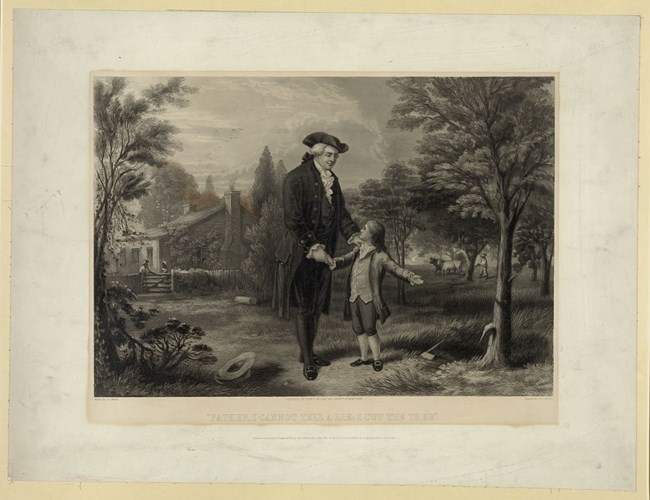Last updated: March 13, 2018
Article
George Washington and the Cherry Tree

Engraving by John C. McRae, 1867.
The story goes that when Washington was six years old, he received a hatchet as a gift, after which he promptly went and cut down his father’s favorite cherry tree. When his father found out about it, he was understandably angry and confronted his son, asking if he had done it, to which little George replied that yes, indeed, he had done it. And with those brave words, father’s anger melted away and he embraced his son, exclaiming that his honesty was worth more than a thousand trees.
That sounds like a nice, uplifting story, but did it happen? Nobody knows for sure.
When Washington died in 1799, there was a great demand around the country to learn more about our first national hero. Minister and itinerant bookseller Mason Locke Weems, more popularly known as Parson Weems, was more than willing to fulfill that need and in 1800 quickly wrote and published The Life of Washington, an immediate bestseller that cemented Washington’s legendary status. It wasn’t until the book’s fifth edition in 1806 that the cherry tree story first made an appearance.
Though profit may have been high on Weems’ priority list in writing this biography, as a minister he wanted to teach morality, and the best way to do that was to show by example using the one individual everyone looked up to. Washington’s admission of guilt was proof that his public greatness was due to his private virtues, to which anyone could aspire. Bringing in the father also served to add more depth to who George Washington was as a person. Though much was known and written about Washington’s military feats, very little was known about his relationship with his father, who had died when George was 11. The cherry tree example of a warm and generous relationship between father and son added strong emphasis to the character of the quickly-being-mythologized George Washington.
So is it true? Weems said he got the story from an elderly woman who had been friends with the family. Since she chose to remain anonymous it is an unreliable source. The official answer from both Ferry Farm, Washington’s childhood home where it would have occurred, and Mount Vernon, is no, it’s only a story. But, really, does it matter?
In 1861, on his way to his inauguration in Washington, D.C., newly-elected president Abraham Lincoln stopped to speak at the New Jersey Senate. He told them he had read a number of books growing up that taught him basic life lessons, Pilgrim’s Progress, Aesop’s Fables, and Lessons in Elocution, to name just a few. But it was The Life of George Washington, he continued, that really sparked his imagination and showed “there must have been something more than common” in Washington and what he had stood for.
For Weems’ book and story to have a good message (i.e. don’t lie) and for it to have made such an impression on someone as equally influential as Lincoln, who are we to protest?
Chop away, Mr. Washington!
